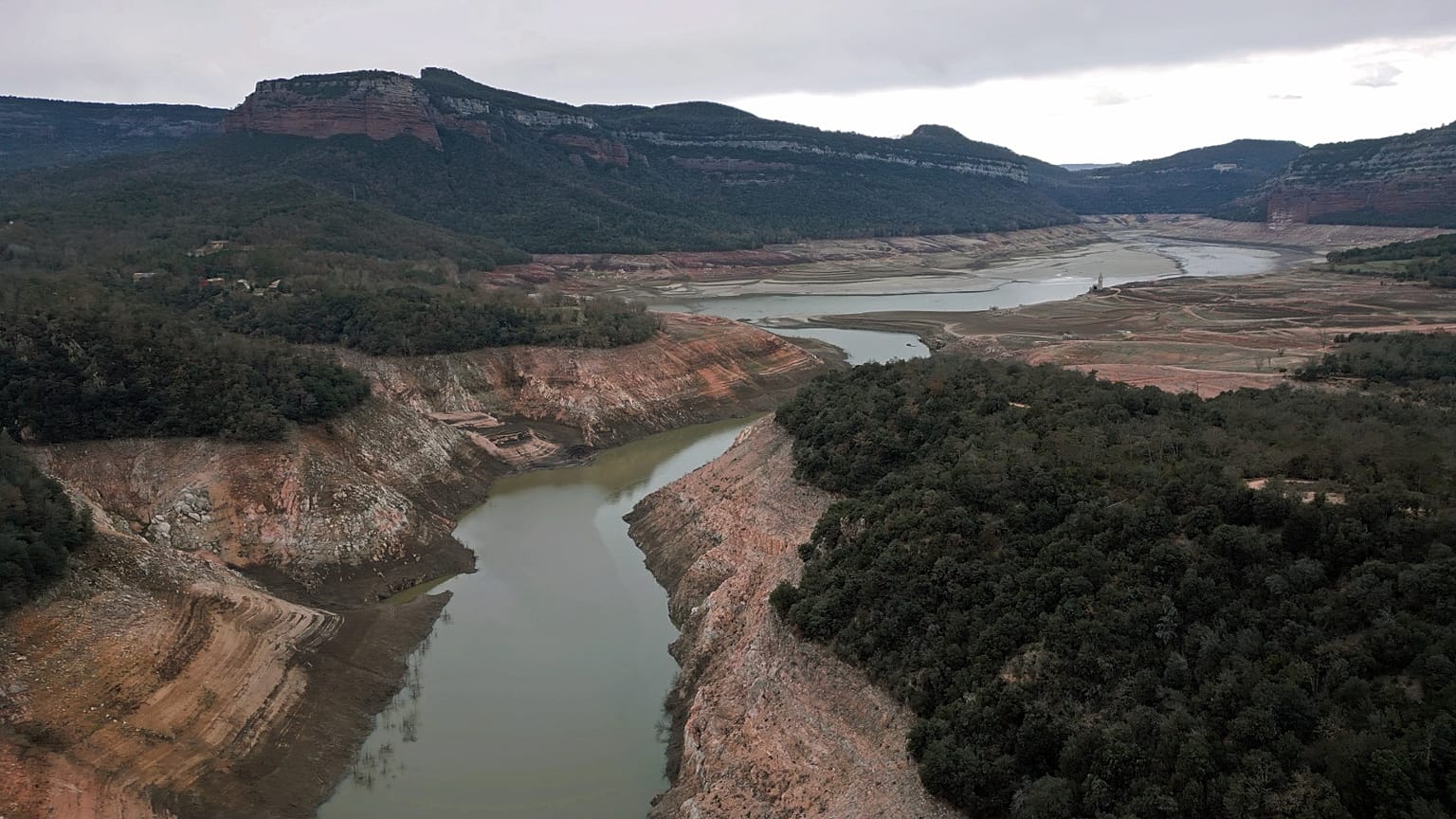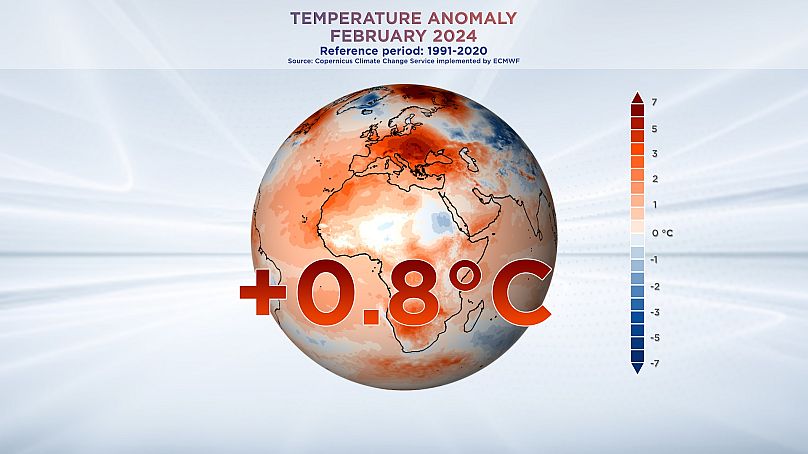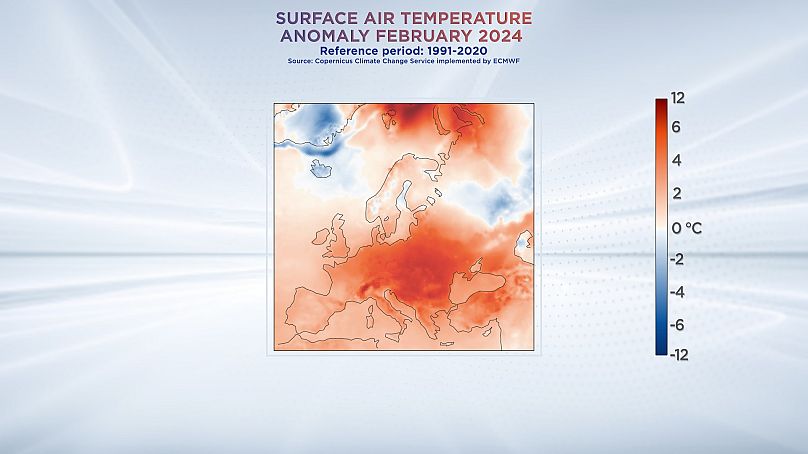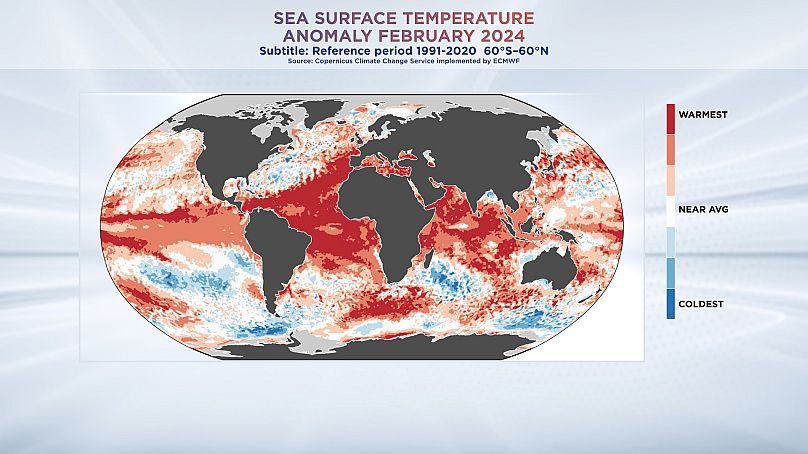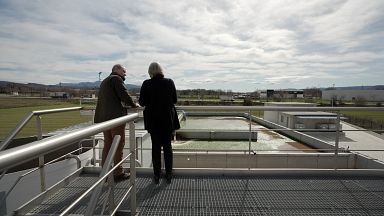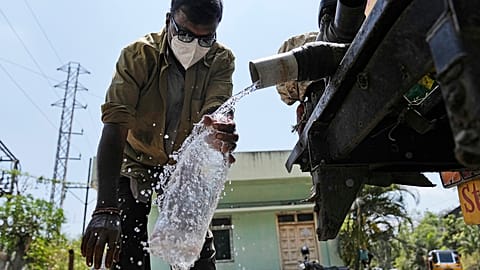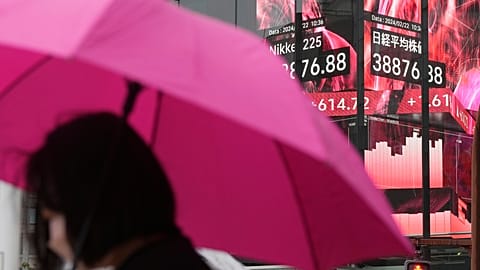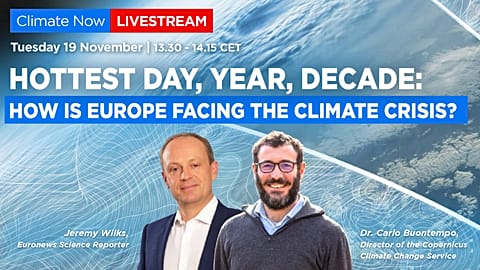How is the Spanish region of Catalonia adapting to drought? The main reservoir that feeds Barcelona is almost empty and the water regeneration and desalination plants are at full capacity. Meanwhile private companies are making their own efforts to economise and recycle water. Is it enough?
"We will change because there's no other option for us," says scientist Vicenç Acuña, as he gestures towards the almost empty Sau reservoir in Catalonia. We should be looking at a huge artificial lake, but instead the concrete wall of the reservoir barrage is bare, towering above the valley and the remaining brown water tens of metres below. It hasn't rained enough in this region for nearly four years, and this reservoir, one of the main supplies for the Barcelona region, is below 15% capacity.
Here in the hinterlands of Catalonia, near the town of Vic, the hills used to be known for cascades and waterfalls, but today they are a draw for tourists and journalists who come to photograph a once-flooded valley turned giant dustbowl.
At the beginning of February, the region declared an official drought emergency, limiting water consumption for agriculture, industry, and private use like refilling swimming pools.
Warmest February on record
Our visit to Catalonia comes as the Copernicus Climate Change Service reports that February was the warmest on record globally, with temperature 0.8 degrees Celsius above the 1991-2020 average.
We have now had nine months in a row of record-breaking warm temperatures for the time of year.
In Europe, there were large warm anomalies in many countries. Temperatures in Romania were 6.8 degrees above average for February, Switzerland was 4.6 degrees above average, and England was 2.9 degrees above the average for the month.
The surface temperature of the ocean outside polar regions also broke a new absolute record, averaging 21.06 degrees Celsius in February.
How is Catalonia adapting?
Today there is growing pressure to accelerate adaptation efforts in Catalonia, a region which is no stranger to drought. Many of the installations now in place were built in response to a long period without significant rain in the late 2000s.
The region is not alone in suffering from a lack of rain, either. Long-lasting, above-average temperatures, warm spells and poor precipitation have led to severe drought conditions at the moment across the Mediterranean region, affecting numerous areas across southern Italy, southern Spain, Malta, Morocco, Algeria and Tunisia.
What does adaptation to drought really involve? Acuña, research scientist at the Catalan Institute for Water Research, said that the first step is “to reconsider the activities that you do, and those that you do not want to change for whatever reason, you need to be more efficient in the use of water”.
"You need to use less water for the same purpose, or reuse water locally so that you do not rely so much on natural water from rivers," he added.
Many of the adaptation initiatives in the region come from private companies. The Hotel Samba in the popular seaside resort of Lloret de Mar is often cited as an example of progressive water management. It began recycling water from showers and washbasins for use in the hotel's toilet systems 25 years ago. They saved over 10,000m3 of water in 2023, according to sustainability manager Laura Pérez Flores.
The hotel is now working with scientists to reuse water from showers and sinks to grow plants. "There are a number of edible vegetables that we are experimenting with to see if it's viable to irrigate them with this grey water," Pérez Flores explained.
Another private water-saving initiative supported by the Catalan Water Partnership is found at meat-processing company Grup Viñas. It invested in its own water treatment plant initially to reduce the fees it paid to the local water company, however it has now begun re-using water in its facilities for cleaning.
Nevertheless, the management expresses frustration at the limitations that Spanish legislation imposes on their water reuse. At the moment, they are only allowed to use 10% of their treated water. Sustainability Manager Nuria Romero told Euronews: "They are asking us to reduce consumption and we are pouring clean water into the sewage system when this water could be used for other purposes."
Today less than half of the water consumed in the Greater Barcelona region comes from conventional sources such as reservoirs. At least 25% of demand is met by the desalination plant at El Prat de Llobregat, close to the airport. The huge facility operates at 100% capacity 24 hours, seven days a week, sucking seawater from the Mediterranean around 2 km offshore and transforming it into potable water for the population.
The publicly-owned site runs on renewable energy and, despite the cost, the Catalan government is committed to expanding this kind of desalination facility, which is more commonly seen in the Middle East and parts of Asia.
"The process to remove salt from seawater is always expensive. It requires a high amount of energy, and that increases the cost of production. But it is no longer a question of higher or lower costs, it is a question of water availability for the population," explained site manager Carlos Miguel.
Next door is a lower-cost water regeneration plant that is also running full-time at full capacity. It takes the water from the sewage treatment plant and processes it through a series of membranes and filtering systems, treating 180,000m3 of water per day and meeting another 25% of demand.
European legislation means that regenerated water cannot simply be pumped into the public water supply, so it is transported around 16 km upstream to be reintroduced into the Llobregat river. The recycled water mixes with the natural river water before it is then extracted again a few kilometres downstream, filtered, and fed into the potable water system. The process, which is rare in Europe, has the added benefit of supporting the natural ecosystems in the lower stretches of the river.
Looking ahead, such artificial cycles are considered the only way that the Barcelona region can sustainably meet the demands of the 6 million people living in the area, and the millions of tourists who visit every year. Local authorities are planning to invest €407 million in projects to achieve the goal of reusing 70% of the water in Catalonia by 2040.
However, Acuña is concerned about the near future. Reflecting on the empty dam at Sau, he warns of “catastrophe in a few months this summer” if there is no significant rainfall. He estimates that Catalonia needs around 550mm of rain this spring to reverse the drought problem.
"We need the governments to really push society through tax incentives or different measures, new laws, to really foster that transition into a water-efficient society," he concluded.
Additional sources: Copernicus Climate Change Service implemented by ECMWF, Associated Press. Special thanks to The Catalan Water Partnershi















